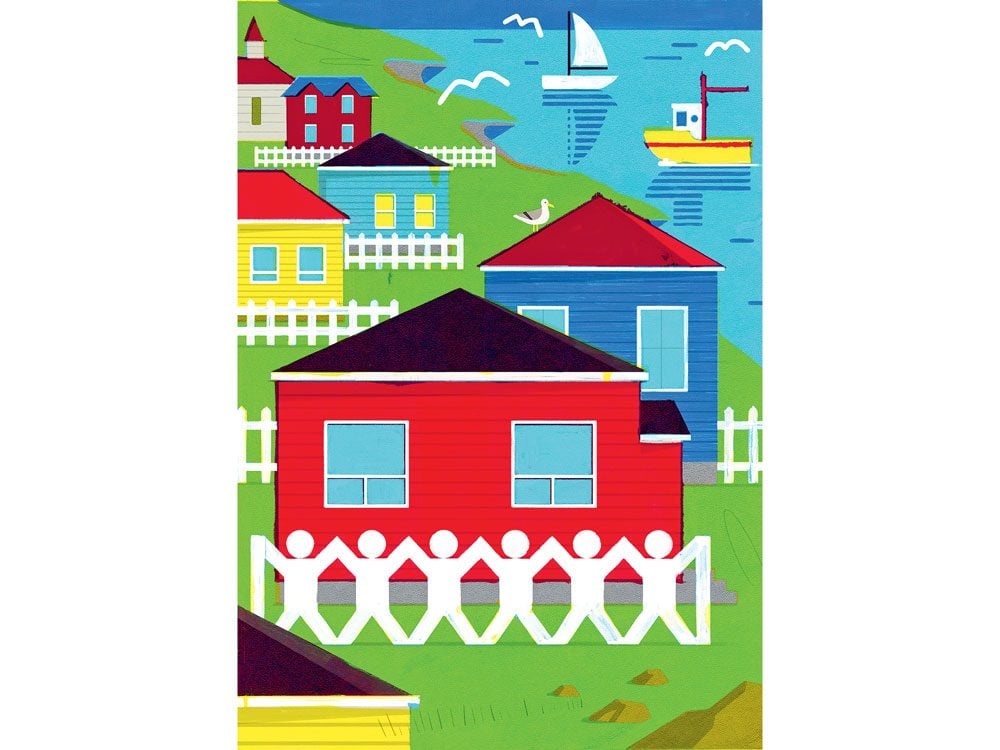
What Makes a Town Autism-Friendly?
In many ways, Channel-Port aux Basques is a typical Newfoundland town. It’s a place where passing strangers say hello and where drivers slow down and smile so pedestrians can jaywalk at their leisure. Newfoundlanders are known for being friendly, but the people of Channel-Port aux Basques have taken human kindness to a whole new level.
Over six years, the town has gone from having zero local resources for kids with autism spectrum disorder (ASD) to becoming Canada’s first autism-friendly town. In the summer of 2017, then-mayor Todd Strickland even made it official with a declaration signing at the town hall.
And it all began with two local women who cared, and wouldn’t take no for an answer.
What is Autism?
The human brain takes in information about the world through all the senses and filters it as required. But imagine if all the information you took in from a simple walk down the street was coming at you all at once, as it does for a child with autism spectrum disorder (ASD). The noise of passing cars, chirping birds and people talking would be like having three radios tuned to different stations at once, turned up so loudly that all you’d want to do is hold your hands over your ears. If you’re nonverbal and not able to tell anybody what you need or how you feel, you might even want to rock or scream or bang your head. (Get to know more conditions that look like autism—but aren’t.)
Autism is a developmental disorder on a spectrum, and every person living with it has a unique pattern and severity of symptoms. Some kids with autism can practically blend in with classmates in a regular school, while others will need caregivers to look after them into their adult lives.
It’s sometimes challenging for the parents of kids with ASD, too: all they want is for their children to feel accepted and be happy. Amazingly, through a grassroots initiative that has captured the imagination of the whole town, Channel-Port aux Basques has become a place where that’s not only possible but also normal.

Channel-Port aux Basques
Of the 300 kids in the town’s elementary school, 14 have been diagnosed with ASD. The Public Health Agency of Canada estimates that ASD affects one in 66 children between the ages of five and 17 in Canada, but numbers are most prevalent in Newfoundland, at one in 57 children. As yet, nobody knows why.
Channel-Port aux Basques, a town of 3,665, is the gateway to Newfoundland and Labrador from mainland Canada—a seven-hour sail from Cape Breton Island. Up until 2013, parents of kids with ASD felt incredibly isolated. If you wanted to join a support group or access basic resources for your child, it was a two-and-a-half-hour drive to the nearest city, Corner Brook.
But that all changed just months after April Billard’s son, William, was diagnosed with ASD in 2010. Billard grew up in Isle aux Morts, a 15-minute drive from Channel-Port aux Basques, where she now lives with her husband and two kids, William, 11, and Gina, 7, who also has autism.
Billard vividly remembers the moment William was diagnosed. Even though he was the same child she knew and loved, everything suddenly seemed different. Instinctively, she’d known a diagnosis was coming because of his speech delays, lack of eye contact and fussiness when touched. Still, she didn’t know much about ASD. Desperate for guidance, she turned to Joan Chaisson, a special-education teacher who had retired a couple years before.
After 30 years of service, not working had been a hard adjustment for Chaisson, then 54, and she was toying with the idea of setting up a consultancy business for parents. She eventually realized, however, that the service would be unsustainable in a small town with limited resources, and she didn’t especially want to ask for money from people whose lives had been turned upside down by a diagnosis. “I couldn’t walk past your house two or three times a day and know you have a child in there who needs help,” she told the Billards. “I’ll do it.”
Learn how to spot the differences between Asperger’s and autism.

Autism Involves Me
Once William’s home-therapy began in 2011, Billard and Chaisson became fast friends. A year later, after venting together about the dire situation for local families dealing with children with ASD, they decided to take matters into their own hands. They resolved to make Channel-Port aux Basques into the town they dreamed of living in—one where parents felt supported and kids with ASD could participate in life to the fullest.
Together, they co-founded Autism Involves Me (AIM) in January 2013, which started out as a parents’ support group with only four members. They would talk about challenges and get their kids together to play in a family room filled with sensory toys. They built a library of specialized parenting books and resources and started thinking about what else they could do to make life richer for their kids outside of that safe bubble.
AIM’s vision was to have autism services and support integrated into the fabric of its members’ hometown, rather than siloed as special-needs offerings. “It’s not that the town wouldn’t do it before,” says Chaisson, explaining that it just took a bit of organization to bring about what was always possible.
Working Towards Inclusivity
Since working with William, Chaisson has moved on to assist several local kids who have ASD, including helping them rehearse life skills out in the community. As she did with William, she breaks down each activity (such as going to the post office or ordering at a restaurant) into steps. But before she does that, she goes into a business to tell staff about the child she is bringing in, including their abilities, challenges and specific goal for the day.
For instance, if a child is struggling with going to loud restaurants, Chaisson might encourage them to just walk through the door so they can see what it looks like. She’ll drop off cue cards to the staff so they can ask the child simple questions they can understand. She might also share a few details about a child’s biggest passion (such as dinosaurs and trains) so the server can throw in a question about that to help them feel comfortable and develop their social skills.
The next step is to get the child to sit in a booth without wanting to make a dash for the door. When that feels comfortable, the child will order from the menu, just as they practised in run-throughs with Chaisson at home.
Chaisson has a way of making people feel inspired and excited about the small changes they can implement to accommodate and welcome families affected by autism. And her outings have had a ripple effect: within months, AIM evolved from a low-key support group into an active movement with 67 members.
What surprised the founders most was how local people who didn’t even have kids on the spectrum wanted to lend their support.
Don’t miss the story of how one woman’s medical battle inspired her to help kids with special needs.

A Little Goes a Long Way
It’s late August 2017 when Chaisson drops into the only barbershop in Channel-Port aux Basques with Elyas, an 11-year-old she is coaching. Barber Edgar Allen recalls the first time he cut the boy’s curls three years ago. “When I say he needed a haircut, I mean he needed a haircut,” he says.
On Elyas’s first visit, Allen had to follow him around the barbershop for a good hour to coax the nervous child to submit to the clippers. But three years after that first cut, Elyas trusts Allen. The barber speaks in a soothing voice. And as Chaisson recommended, he always shows kids with autism the instrument he is about to use and guides them through the next step so the vibration of clippers or the sensation of gel on the scalp won’t shock a child with sensory sensitivities.
On this visit, after only 20 minutes in the chair, Elyas is giggling as Allen blows stray clippings off his neck with a converted vacuum. “You see how calm he is now?” says Allen, as he offers the boy a lollipop for each hand.
What Allen does in his barbershop isn’t groundbreaking, but little changes can make a huge difference for kids with ASD. As Billard says, “When you’re the mom of a child with autism, it’s just so easy to think that nobody will ever have your back. But when you have people in your community who are willing to learn, it means a lot.”
Things are Going Swimmingly
In any coastal town, where life revolves around boats and beaches, every child should learn how to swim. For kids with ASD, it’s vital. “Children who are on the autism spectrum are drawn to water,” says Wanda Merrigan, the facility manager at the Bruce II Sports Centre. A recent report from Columbia University states that Americans with ASD have a substantially heightened risk for death from injury, with drowning among the top causes.
Unfortunately, for children with ASD, group swimming lessons can feel like an assault on the senses—voices bouncing off concrete walls, getting splashed by surprise and the screech of blowing whistles. After Chaisson and the AIM group came to chat with the Sports Centre’s team about how they could do things differently, they decided to offer one-on-one classes for kids on the spectrum. Merrigan hand-picked three swimming instructors she knew would be patient and flexible.
Typically, swimming teachers check off boxes as the kids learn new skills in a set order. But for these private lessons, Chaisson instructed the young teachers to take their cues from the kids themselves. The children might spend the first nine lessons simply wading in the shallow end. Then, on week 10, all of a sudden they’ll want to venture out of their depth with a flotation device, maybe even try to dog-paddle. “It’s always a good day when a child learns to swim,” says Merrigan, “and the days when children on the spectrum do it are doubly exciting—everybody cheers.”
As one of the group’s special swimming instructors, 18-year-old Chloe Munden felt empowered by what she learned. “It has made me a more understanding person,” she says. “I’m really proud that I can help people reach their goals.”
Kids with autism also come to the Bruce II for the full gamut of fitness activities. They use the centre’s bowling alley during off-peak hours, and staff bring down a small trampoline for the kids to bounce on between turns to work out their anxiety and develop patience. And in partnership with AIM, the centre now has a mini-gym full of sensory-play equipment, including “the squeeze machine,” a piece of apparatus with giant foam rollers that kids can roll their entire bodies through. It provides a soothing sensation for many kids with ASD and is just plain fun for all the preschoolers in the town.
Don’t miss the inspiring story of how one Alberta man with autism is inspiring families to rethink what their children can achieve.

Be Our Guest
“I love this place,” says Isaac, a 10-year-old child on the spectrum who has grown up in Channel-Port aux Basques. It’s the third week of August in 2017, and he is on a boat tour with local lobster fishermen, zipping past the town’s boardwalk. Isaac especially enjoys Cheeseman’s Beach (“The orange flowers there look like the fire flowers in Mario!”) and is fascinated by the region’s geology (“I have a collection of 48 rocks!”). But his favourite place in town is the sensory room that opened at Hotel Port aux Basques earlier that year.
Chaisson had approached Cathy Lomond, the hotel’s owner, to suggest that she make the hotel autism-friendly for local kids and travellers. A singer-songwriter in her spare time, the hotelier has a sister with Down’s syndrome and needed no convincing. She ended up making so many changes for ASD families that Hotel Port aux Basques was dubbed “Canada’s first autism-friendly hotel” in national media, and the phone rang off the hook with bookings.
In addition to repurposing a staff gym into a room filled with calming toys, books and sensory equipment, Lomond made a digital slide show tour of her hotel to help kids with ASD cope with the unfamiliar.
She also created picture menus for the dining room so non-verbal kids could point to their meals of choice. <(The kitchen will also make special meals to accommodate dietary restrictions and re-create favourite dishes from home.) The Autism Society of Newfoundland and Labrador (ASNL) came in to train hotel staff. “When word got around that we were doing autism-sensitivity training, other businesses asked if they could send employees, so we opened up the hotel and did a second session,” says Lomond. “It really makes me proud that our community has gone out of its way to accommodate children on the autism spectrum.”
Here to Stay
As Isaac prepares to leave his beloved sensory room, he makes an announcement. “This hotel deserves to be treated to more than three-and-a-half stars,” he says, striding through the lobby. “Maybe four-and-a-half stars?” he adds. “And if they had a swimming pool, maybe even five.”
“You don’t have to throw millions of dollars at a program,” says Isaac’s mother, Candace Matthews. “You don’t have to build anything. All you have to do is open your mind, ask questions and be open to making small changes and accommodations. I would never consider leaving Port aux Basques now. It’s just golden—you wouldn’t believe it.”
Next, find out what it’s like living with someone with autism.